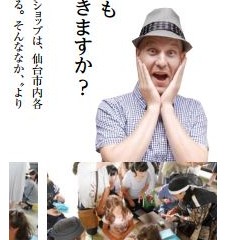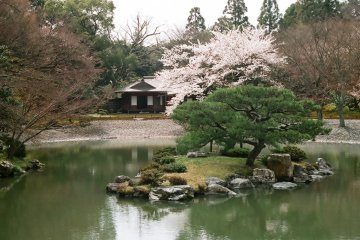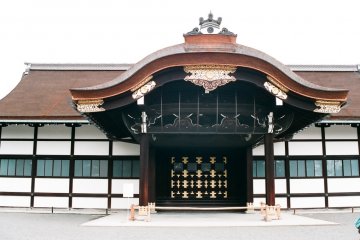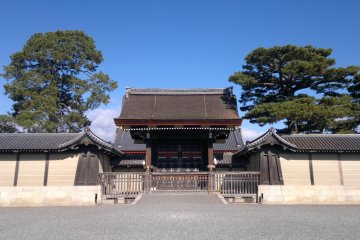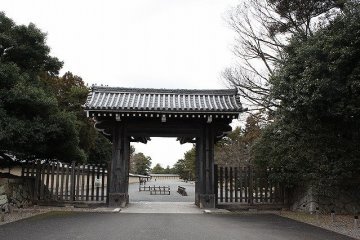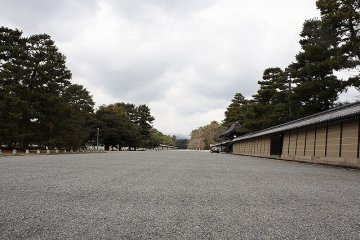The Kyoto Imperial Palace is actually a part of Kyoto Gyoen National Park. During the Meiji Restoration, aristocrats of the court and residents around the Imperial Palace moved from Kyoto to Tokyo along with the new Emperor. But some ten years or so after the move, the Kyoto Imperial Palace and its surroundings were left abandoned and fell into a tragic state of disrepair. Realizing this, Emperor Meiji (the new emperor) now in Tokyo, ordered its redevelopment and management.
Behind the Nashinoki Shrine on the east side of Kyoto Gyoen National Park is Seiwaiin Gate. Pass through the gate and you can see a little of the Imperial Palace. Continue alongside the former palace, using the narrow gravel road. It is as if you could imagine hearing the cheerful chatter of courtesans in the middle of kemari, a once popular ball kicking game played at court.
Of all the historical emperors, I personally have a heightened interest in Emperor Saga. This is because the stability of the Heian period as demonstrated in the Tale of Genji (considered the world's first novel) was created under his rule.
It was the sixth of September, 810 by the western calendar. The head of police and judicial duties, Sakanoue no Tamuramaro, reported an incident to Emperor Saga regarding Heijyokyo, the old capital in ancient Nara. The investigation in question regarded the role of Emperor Saga's elder brother and previous emperor, Heizei, and his lover Kusuko no Fujiwara. The two were trying to reverse the imperial relocation ordinance which transferred the capital from Nara to Kyoto. Retired emperors at that time still wielded political power and some authority. The old emperor Heizei wanted the capital moved back to his domain and the new emperor Saga was set to stop any such plan.
Emperor Heizei was crowned in 806, taking over the position from his father Emperor Kammu. He was an intelligent man, but his body was weak, causing him to become ill easily. Shortly after ascending the throne, it would have been the norm for Emperor Heizei to have engaged in a relationship with an appropiate consort. However, he had an affair not with a consort but his consort's mother, Kusuko no Fujiwara. Such a relationship at the time was strictly taboo. The news became quickly known to Emperor Kammu. Kusuko was expelled from the Imperial Palace the same day. Emperor Heizei's frustrating ordeal losing his love led him to became depressed. He consequently secluded himself, busying his days with office work.
Three years later in 809, Emperor Heizei's depression and subsequent illness was seen as too much for him to properly rule from the throne. He was forced to retire, making Emperor Saga the new imperial ruler. Strangely, soon after this happened, former emperor Heizei made a full recovery and became full of energy. Ignoring his complaining father the former Emperor Kammu, Heizei summoned his separated lover Kusuko and restarted their forbidden relationship. More importantly, he spread the word he was again assuming power and asked for support from his past retainers and allies. It was risky business trying to regain and retain power, and doing so with Kusuko was twice as dangerous. The young, inexperienced emperor blinded by love could be easily manipulated.
Kusuko and Kusuko's elder brother fueled the fire of the growing tension between Heizei and Saga. If Heizei could once again become reigning emperor, their own status' and power would be greatly increased. They started to plan a rebellion. Emperor Saga found out about the plan and assembled his own forces. He ordered Sakanoue to rally the clans loyal to him then march towards Heijokyo. Emperor Saga's forces encircled the old palace and had the false Emperor Heizei and his soldiers trapped.
Those in the uprising were soon executed by dozens of razor sharp arrows. Kusuko was allowed to commit suicide in front of Emperor Saga by drinking poison. Saga said to Heizei, ''Brother, this is disgusting. How dare you become involved with this woman again.'' Emperor Saga spared his elder brother and allowed him to shave his head to become a monk.
Emperor Saga was famous as a formidable politician. Unlike today's symbolic Emperor, Emperor Saga demonstrated political power comparable to that of today's President of the United States or China's Prime Minister. In the chronicles of Japanese history, it was the first time that such a long period of stability, over 300 years, was created. It was all thanks to Emperor Saga.


